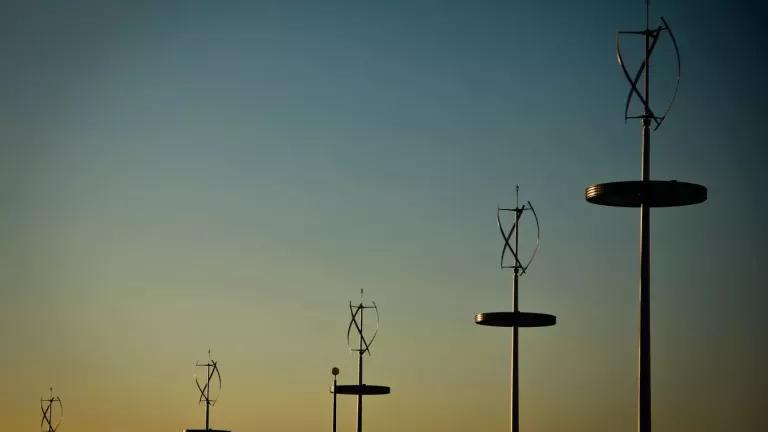Spitting into the Wind
Property owners fight wind farms, but the numbers are in: They have no effect on property values.

Vertical axis wind turbines in Olympic Park, London.
Photo: Natesh Ramasamy
Pick three adjectives to describe a wind turbine’s appearance.
What did you come up with? You might have selected graceful, metronomic, and beautiful. It’s equally likely you picked monstrous, obtrusive, and hideous. The aesthetics of turbines, which can be hundreds of feet tall, seem to divide American sensibilities more or less down the middle, like modern art or Ariana Grande.
Fostering heated debate is good if you’re Jeff Koons, but it’s a huge pain if you’re trying to site a wind farm. Public hearings too often descend into arguments over such matters of taste. Author Robert Righter described one fight in the early 1980s, when a regional planner described turbines installed in northern California as “exoskeletal outer-space creations” turning open green space into “iron forests.” Another commenter characterized the same windmills as “kinetic sculpture.”
This long-running dispute leaves us with a single, burning question: Should anyone care what these passionate aesthetes think?
The answer, so far, appears to be “no.” Study after study conducted within the United States and without, looking at urban areas and rural ones, has shown that windmills have no detectable effect on property values—which is probably the best way to determine whether the aesthetics actually matter. The most recent contribution emerged this week in the Canadian Journal of Agricultural Economics. University of Guelph economist Richard Vyn analyzed homes and farms in the vicinity of a 133-turbine wind farm in Ontario, finding that the installation didn’t significantly affect the price of land.
But here’s the odd thing: No matter how many of these studies come out, people who live near proposed wind farm sites argue that the turbines will undercut their home values. The Ontarians in Vyn’s recent study urged the local government to stall or halt the wind farm. Other studies have found that the announcement of a future wind farm temporarily depresses nearby property values, with prices springing back to normal after construction is complete.
People in the field refer to this phenomenon as the “anticipation effect”—the idea of living near a wind farm is much scarier than the reality. It’s exactly like the anxiety you feel just before getting your flu vaccine. (Just keep a steady conversation going with the nurse and, for heaven’s sake, do not look at the needle.) The shot causes some discomfort, but it shouldn’t stop you from getting vaccinated.
The anticipation effect isn’t entirely irrational, of course, even if the data suggests that the fear is misplaced or overstated. Wind turbines can be noisy, especially the older ones, and, people have reported annoyance with the sound. There is also the “shadow flicker” associated with the constantly rotating blades, which many homeowners find maddening.
These problems are manageable. Engineers are working on noise mufflers, passive noise technologies, and other design tweaks to minimize the whirring. Governments also have the power to enforce margins between the turbines and the edge of the farm’s property. This would diminish the noise for nearby houses as well as reduce the number of homes exposed to the flickering shadows.
Unfortunately, there’s not much to be done for people disgusted with the sight of “exoskeletal outer-space creations” in their backyard. There are alternative designs in tight urban spaces, but they aren’t economically efficient for large-scale wind farms. Several researchers think vertical axis wind turbines are the future, but that's still many years away. And besides, if the traditional turbine doesn’t rev your engine, you’re unlikely to find these newfangled models any better. For instance, it’s hard to picture wooden-clogged Dutch children frolicking around them.
The aesthetic sensibilities of a few shouldn’t stop progress, though. Wind is now responsible for 4 percent of U.S. electricity. In Iowa and South Dakota, it accounts for more than one-quarter of electricity production. And there is plenty of room to grow. Nearly a third of new production capacity in the last five years was wind.
There are lots of things you might legitimately not want sited in your backyard because they will significantly depress property values, like major highways (by 5.3 percent), electricity transmission lines (9.3 percent), and landfills (12.2 percent). A wind farm may not have the same effects on property values as say, a beachfront (plus 26 percent), but, at the same time, a home by the sea isn’t going to help save life as we know it.
This article was originally published on onEarth, which is no longer in publication. onEarth was founded in 1979 as the Amicus Journal, an independent magazine of thought and opinion on the environment. All opinions expressed are those of the authors and do not necessarily reflect the policies or positions of NRDC. This article is available for online republication by news media outlets or nonprofits under these conditions: The writer(s) must be credited with a byline; you must note prominently that the article was originally published by NRDC.org and link to the original; the article cannot be edited (beyond simple things such grammar); you can’t resell the article in any form or grant republishing rights to other outlets; you can’t republish our material wholesale or automatically—you need to select articles individually; you can’t republish the photos or graphics on our site without specific permission; you should drop us a note to let us know when you’ve used one of our articles.

Wind Energy
What’s the Most Energy-Efficient Water Heater?
How to Ditch the Biggest Fossil Fuel Offenders in Your Life